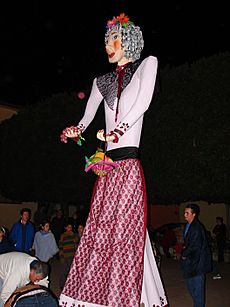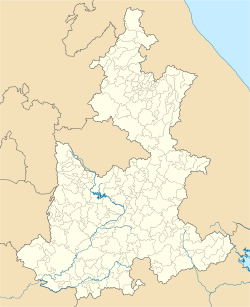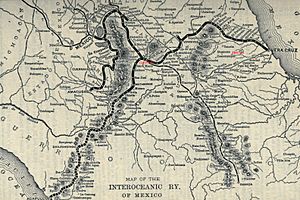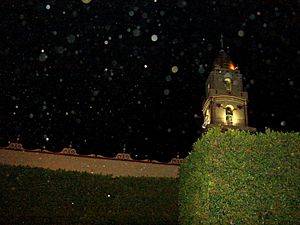Chipilo facts for kids
Quick facts for kids
Chipilo
|
||
|---|---|---|
| Chipilo de Francisco Javier Mina | ||

The Parish of Immaculate Conception from above
|
||
|
||
| Country | ||
| State | Puebla | |
| Municipality | San Gregorio Atzompa | |
| Population
(2010)
|
4,059 | |
| Demonyms | Spanish: chipileño Venetian: cipilegni |
|
Chipilo, officially called Chipilo de Francisco Javier Mina, is a small town in the state of Puebla, Mexico. It is located about 12 kilometers (7.5 miles) south of the state capital, Puebla, Puebla. Chipilo sits high up, about 2,150 meters (7,054 feet) above sea level.
The name "Chipilo" comes from the Náhuatl language. It means "place of the whiner." This town was started by Italian immigrants in the late 1800s.
Contents
History of Chipilo
In 1879, the area that is now Chipilo was known as Colonia Fernández Leal. Then, on October 2, 1882, a group of immigrants from the Veneto region in northern Italy began to settle there. Most of them came from the town of Segusino and other nearby places in the province of Treviso.
These Italian families left their homes because of poverty in Veneto. They came to Mexico looking for good land to farm. Many of them started raising cattle, and soon, Chipilo's dairy products became very popular in Puebla and other parts of central Mexico.
In 1899, Chipilo was officially declared a town. The name "de Francisco Javier Mina" was added to honor Martín Javier Mina y Larrea, a hero. However, local people still just call it "Chipilo."
Keeping Traditions Alive
Even today, some Italian-Mexicans in Chipilo speak a special dialect. It's called the Chipilo Venetian dialect, and it comes from the old Venetian language. This shows how well they kept their culture. In 1917, they even bravely defended their town from attacks by Mexican revolutionaries.
For much of the 1900s, Chipilo stayed quite separate from the big city of Puebla. This isolation helped the "Chipileños" (as they are called) keep their traditions and language strong. Unlike other Italian immigrants in Mexico, they didn't mix as much with Mexican culture.
The Venetian dialect spoken in Chipilo is a specific type called 'northern Feltrino-Bellunese'. It's amazing how little it has changed, even though Spanish is spoken all around them. Because so many people in Chipilo speak Venetian, it can be seen as a minority language in the Puebla area.
In 1982, the people of Chipilo celebrated their town's 100th birthday. Visitors from the Veneto region of Italy joined them. During this celebration, Segusino, Italy, became Chipilo's Twin city.
Culture and Life in Chipilo

Chipilo was founded by Italian immigrants, mostly from the Veneto region. Some also came from Piedmont and Lombardy. They worked hard to keep their northern Italian culture alive.
A local writer, Eduardo Montagner Anguiano, described Chipilo well. He said that Chipilo has kept its original Italian look, culture, and dialect. For language experts, Chipilo is like a treasure. It's a rare example of a town that moved to another country but kept its language and customs almost exactly as they were in the 1800s.
To their Mexican neighbors, the "güeros" (a local nickname for the Italians) of Chipilo are unique. They are known for being strong, often having blond or red hair, and for being very careful with money. The town is clean, with no trash or political signs everywhere. You won't see kids playing soccer in the streets as much as in other Mexican towns.
Instead, Chipilo has a Salesian convent, three schools, and a "Casa de Italia" (House of Italy). There's also a library, a town hall, and shops selling sausages, cold meats, and cheeses. You can find a couple of cafes and two banks. The streets are paved, and many homes have stables and carpentry workshops in their backyards. About 2,700 people live here, all descendants of the 424 immigrants who arrived in 1882.
Most of the first settlers came from Segusino and nearby villages. These include places like Quero, Valdobbiadene, Feltre, and Maser in the Treviso and Belluno provinces.
Notable People
- Eduardo Montagner Anguiano, a writer.
- Martín Stefanonni Mazzocco, a politician.
Twin towns – sister cities
See also
 In Spanish: Chipilo para niños
In Spanish: Chipilo para niños






